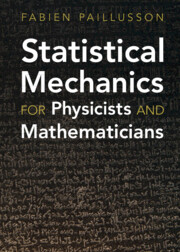Book contents
- Frontmatter
- Contents
- Preface
- List of Mathematical Symbols
- 1 What Is Statistical Mechanics For?
- 2 Probability Theory
- 3 Gibbs Statistical Mechanics
- 4 Connecting Thermodynamics with Statistical Mechanics
- 5 Quantum Statistical Mechanics
- 6 Quantum Statistical Mechanics for Systems of Identical Part
- 7 Introduction to the Thermodynamical and Statistical Descriptions of Phase Transitions
- Appendix A Legendre Transformations
- Appendix B Lagrangian and Hamiltonian Formalism for Fields
- Appendix C Euler Gamma Function and Hyper Volume of a Sphere
- Appendix D Vector Space, Dual Space and Hilbert Space
- Appendix E Solutions to Warm-Up Exercises
- References
- Index
4 - Connecting Thermodynamics with Statistical Mechanics
Published online by Cambridge University Press: 28 July 2025
- Frontmatter
- Contents
- Preface
- List of Mathematical Symbols
- 1 What Is Statistical Mechanics For?
- 2 Probability Theory
- 3 Gibbs Statistical Mechanics
- 4 Connecting Thermodynamics with Statistical Mechanics
- 5 Quantum Statistical Mechanics
- 6 Quantum Statistical Mechanics for Systems of Identical Part
- 7 Introduction to the Thermodynamical and Statistical Descriptions of Phase Transitions
- Appendix A Legendre Transformations
- Appendix B Lagrangian and Hamiltonian Formalism for Fields
- Appendix C Euler Gamma Function and Hyper Volume of a Sphere
- Appendix D Vector Space, Dual Space and Hilbert Space
- Appendix E Solutions to Warm-Up Exercises
- References
- Index
Summary
This chapter follows a logic of exposition initiated by Gibbs in 1902. On the one hand, some theoretical results in statistical mechanics have been derived in Chapter 3, while, on another hand, some theoretical/experimental results are expressed within thermodynamics, and parallels are drawn between the two approaches. To this end, the theory of thermodynamics and its laws are presented. The chapter takes an approach where each stated law is attached to a readable source material and a person’s writing. The exposition of the second law follows the axiomatics of Carathéodory, for example. This has the advantage of decoupling the physics from the mathematics. The structure of thermodynamic theory with the scaling behaviour of thermodynamic variables, Massieu potentials and Legendre transformations is also developed. Finally, correspondence relations are postulated between thermodynamics and statistical mechanics, allowing one to interpret thermodynamic variables as observational states associated to certain probability laws. Applications are given, including the Gibbs paradox. The equivalence between the canonical and the microcanonical ensembles is analysed in detail.
Keywords
Information
- Type
- Chapter
- Information
- Statistical Mechanics for Physicists and Mathematicians , pp. 111 - 167Publisher: Cambridge University PressPrint publication year: 2025
